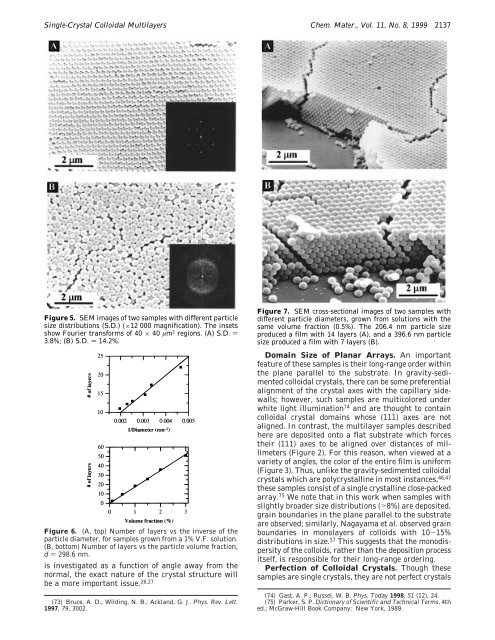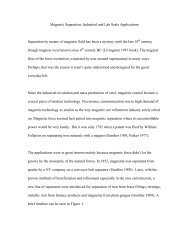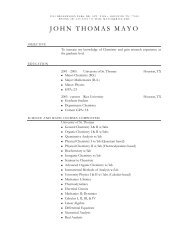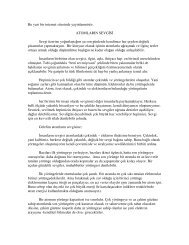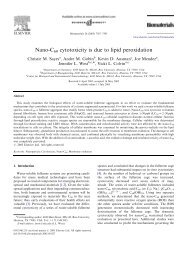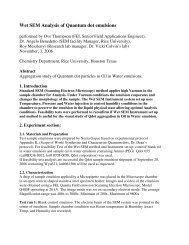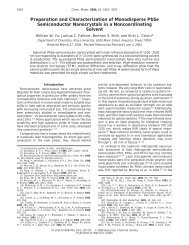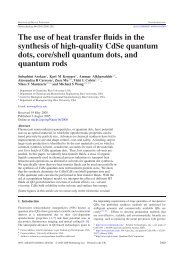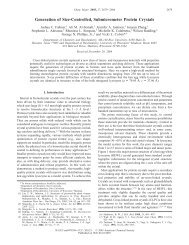Single-Crystal Colloidal Multilayers of Controlled Thickness
Single-Crystal Colloidal Multilayers of Controlled Thickness
Single-Crystal Colloidal Multilayers of Controlled Thickness
You also want an ePaper? Increase the reach of your titles
YUMPU automatically turns print PDFs into web optimized ePapers that Google loves.
<strong>Single</strong>-<strong>Crystal</strong> <strong>Colloidal</strong> <strong>Multilayers</strong> Chem. Mater., Vol. 11, No. 8, 1999 2137<br />
Figure 5. SEM images <strong>of</strong> two samples with different particle<br />
size distributions (S.D.) (×12 000 magnification). The insets<br />
show Fourier transforms <strong>of</strong> 40 × 40 µm 2 regions. (A) S.D. )<br />
3.8%; (B) S.D. ) 14.2%.<br />
Figure 6. (A, top) Number <strong>of</strong> layers vs the inverse <strong>of</strong> the<br />
particle diameter, for samples grown from a 1% V.F. solution.<br />
(B, bottom) Number <strong>of</strong> layers vs the particle volume fraction,<br />
d ) 298.6 nm.<br />
is investigated as a function <strong>of</strong> angle away from the<br />
normal, the exact nature <strong>of</strong> the crystal structure will<br />
be a more important issue. 26,27<br />
(73) Bruce, A. D.; Wilding, N. B.; Ackland, G. J. Phys. Rev. Lett.<br />
1997, 79, 3002.<br />
Figure 7. SEM cross-sectional images <strong>of</strong> two samples with<br />
different particle diameters, grown from solutions with the<br />
same volume fraction (0.5%). The 206.4 nm particle size<br />
produced a film with 14 layers (A), and a 396.6 nm particle<br />
size produced a film with 7 layers (B).<br />
Domain Size <strong>of</strong> Planar Arrays. An important<br />
feature <strong>of</strong> these samples is their long-range order within<br />
the plane parallel to the substrate. In gravity-sedimented<br />
colloidal crystals, there can be some preferential<br />
alignment <strong>of</strong> the crystal axes with the capillary sidewalls;<br />
however, such samples are multicolored under<br />
white light illumination 74 and are thought to contain<br />
colloidal crystal domains whose (111) axes are not<br />
aligned. In contrast, the multilayer samples described<br />
here are deposited onto a flat substrate which forces<br />
their (111) axes to be aligned over distances <strong>of</strong> millimeters<br />
(Figure 2). For this reason, when viewed at a<br />
variety <strong>of</strong> angles, the color <strong>of</strong> the entire film is uniform<br />
(Figure 3). Thus, unlike the gravity-sedimented colloidal<br />
crystals which are polycrystalline in most instances, 46,47<br />
these samples consist <strong>of</strong> a single crystalline close-packed<br />
array. 75 We note that in this work when samples with<br />
slightly broader size distributions (>8%) are deposited,<br />
grain boundaries in the plane parallel to the substrate<br />
are observed; similarly, Nagayama et al. observed grain<br />
boundaries in monolayers <strong>of</strong> colloids with 10-15%<br />
distributions in size. 57 This suggests that the monodispersity<br />
<strong>of</strong> the colloids, rather than the deposition process<br />
itself, is responsible for their long-range ordering.<br />
Perfection <strong>of</strong> <strong>Colloidal</strong> <strong>Crystal</strong>s. Though these<br />
samples are single crystals, they are not perfect crystals<br />
(74) Gast, A. P.; Russel, W. B. Phys. Today 1998, 51 (12), 24.<br />
(75) Parker, S. P. Dictionary <strong>of</strong> Scientific and Technical Terms, 4th<br />
ed.; McGraw-Hill Book Company: New York, 1989.


